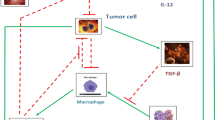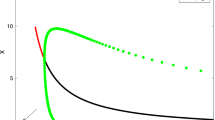Abstract
We present a delay model to describe the interaction between tumour and immune system. We begin this model with proving non-negativity and boundedness of the solution. Stability and existence of local Hopf bifurcation are studied by analyzing the transcendental characteristic equation. We construct a Lyapunov functional to ensure global stability of tumour-free steady state that exists. We establish the existence of an optimal control for this model and provide necessary conditions for the optimal (ACI with IL-2 therapy) treatment. Sensitivity analysis is performed on a delay differential equation model for tumour-immune system. Numerical simulations are carried out to explain the mathematical conclusions.








Similar content being viewed by others
References
Adam JA, Bellomo N (eds) (1997) A survey of models for tumourimmune system dynamics. Birkhäuser, Boston
Norris ES, King JR, Byrne HM (2006) Modelling the response of spatially structured tumours to chemotherapy: drugkinetics. Math Comput Model 43:820–837
Araujo R, McElwain D (2004) A history of the study of solid tumour growth: the contribution of mathematical modeling. Bull Math Biol 66:1039–1091
Bellomo N, Li N, Maini P (2008) On the foundations of cancer modeling: selected topics, speculations, and perspectives. Math Models Methods Appl Sci 18:593–646
Bellomo N, Preziosi L (2000) Modelling and mathematical problems related to tumour evolution and its reactions with immune system. Math Comput Model 32:413–452
Castiglione F, Piccoli B (2007) Cancer immunotherapy, mathematical modeling and optimal control. J Theor Biol 247:723–732
Chaplain M (2008) Modelling aspects of cancer gorowth: insights from mathematical and numerical analysis and computational simulation. Lecture notes in mathematics, multiscale problems in the life sciences, Springer 1940, pp 147–200
Krischner D, Panetta J (1998) Modelling immunotherapy of the tumour-immune system interaction. J Math Biol 37:235–252
Denise K, Alexei T (2009) On the global dynamics of a model for tumour immunotherapy. J Math Biosci Eng 6(3):573–583
Martins ML, Ferreira SC Jr, Vilela MJ (2007) Multiscale models for the growth of avascular tumours. Phys Life Rev 4:128–156
Nagy J (2005) The ecology and evolutionary biology of cancer: a review of mathematical models of necrosis and tumour cells divesity. Math Biosci Eng 2:381–418
Siu H, Vitetta ES, May RD, Uhr IW (1986) Tumour dormancy. I. Regression of \(BCL_1\) tumour and induction of a dormant tumour state in mica chimeric at the major histocompatibility complex. J Immunol 137:1376–1382
Yafia R (2007) Hopf bifurcation analysis and numercical simulations in an ODE model of the immune system with positive immune response. Nonlinear Anal Real World Appl 8:1359–1369
Kuznetsov VA, Makalkin IA, Taylor M, Perelson AS (1994) Nonlinear dynamics of immunogenic tumours: parameter estimation and global bifuracation analysis. Bull Math Biol 56:295–321
Scalerandi M, Romano A, Pescarmona GP, Delsanto PP, Condat CA (1999) Nutrient competition as a determinant for cancer growth. Phys Rev E 59:2206–2217
Kansal AR, Torquato S, Harsh GR IV, Chiocca EA, Deisboeck TS (2000) Simulated brain tumour growth dynamics using a three dimensional cellular automaton. J Theor Biol 203:367–382
Ferreira SC Jr, Martins ML, Vilela MJ (2002) Reaction diffusion model for the growth of avascular tumour. Phys Rev E 65–021907:1–8
Scalerandi M, Capogrosso Sansone C, Benati C, Condat CA (2002) Competition effects in the dynamics of tumour cords. Phys Rev E65–051918:1–10
Galach M (2003) Dynamics of the tumour-immune system competition the effect of time delay. Int J Appl Math Comput 13(3):395–406
Forys U (2002) Marchuk’s model of immune system dynamics with applications to tumour growth. J Theor Med 4(1):85–93
Szymańska Z (2003) Analysis of immunotherapy models in the context of cancer dynamics. Int J Appl Math Comput 13(3):407–418
Mallet DG, DePillis LG (2006) A cellular automata model of tumour-immunesystem interactions. J Theor Biol 239:334–350
DePillis LG, Mallet DG, Radunskaya AE (2006) Spatial tumour-immune modeling. Comput Math Methods Med 7:159–176
Menchón SA, Ramos RA, Condat CA (2007) Modeling subspecies and the tumour-immune system interaction: steps towards understanding therapy. Phys A 386:713–719
Sandip Banerjee S (2008) Immunotherapy with interleukin-2: a study based on mathematical modelling. J Appl Math Comput Sci 18(3):389–398
Kuznetsov VA, Makalkin MA, Taylor MA, Perelson AS (1994) Nonlinear dynamics of immunogenic tumours: parameter estimation and global bifurcation analysis. Bull Math Biol 56(2):295–321
Mayer H, Zanker KS, Der Heiden U (2006) A basic mathematical model of the immune response. Chaos 5:155–161
Hara I, Hotta H, Sato N, Eto H, Arakawa S, Kamidono S (1996) Rejection of mouse renal call carcinoma elicited by local secretion of interleukin-2. Jpn J Can Res 87(7):724–729
Kaempfer R, Goerz L, Farbstein H, Madar L, Hirschman O, Nussinovich R, Shapiro A (1996) Prediction of response to treatment in superficial bladder carcinoma through pattern of interleukin-2 gene expression. J Clin Oncol 14(6):1778–1786
Keilholz U, Scheibenbogen C, Stoelben E, Saeger H, Hunstein W (1994) Immunotherapy of metastatic melanoma with interferonalpha and interleukin-2: pattern of progression in responders and patients with stable disease with or without resection of residual lesions. Eur J Cancer 30A(7):955–958
De Pillis LG, Radunskaya A (2003) The dynamics of an optimally controlled tumour model: a case study. Math Comput Model 37(11):1221–1244
Swan GW (1985) Optimal control applications in the chemotherapy of multiple myeloma. IMA J Math Appl Med Biol 2(3):139–160
Byrne HM (1997) The effect of time delays on the dynamics of avascular tumour growth. Math Biosci 144(2):83–117
Bodnar M, Forys U (2003a) Time delays in proliferation process for solid avascular tumour. Math Comput Model 37(11):1201–1209
Bodnar M, Forys U (2003b) Time delays in regulatory apoptosis for solid avascular tumour. Math Comput Model 37(11):1211–1220
Banerjee S, Sarkar RR (2008) Delay induced model for tumour-immune interaction and control of malignant tumour growth. Bioscience 91(1):268–288
Yafia R (2006) Dynamics analysis and limit cycle in a delayed model tumour growth with quiescence. Nonlinear Anal Model Control 11:95–110
Yafia R (2007) Hopf bifurcation in differential equations with delay for tumour-immune system competition model. SIAM J Appl Math 67(6):1693–1703
Alexei T, Banerjee S (2014) Bounded immune response in immunotherapy described by deterministic delay Kirschner-Panetta model. J Appl Math Lett 35:90–94
Starkov Konstantin E, Coria Luis N (2013) Global dynamics of the Kirschner–Panetta model for the tumour immunotherapy. Nonlinear Anal Real World Appl 14:1425–1433
Mark R-T, Ardith E-K, Goriely A (2012) A mathematical model of tumor-immune interactions. J Theor Biol 294:56–73
Kiran KL, Lakshminarayanan S (2010) Global sensitivity analysis and model based reactive scheduling of targeted cancer inmmunotherapy. J Biosyst 101:117–126
Thalya B, Jon E, Fister RK (2004) Optimal control applied to immunotherapy. Discrete Contin Dyn Syst Ser B 4(1):135–146
Rihan FA, Abdel Rahman DH, Lakshmanan S, Alkhajeh AS (2014) A time delay model of tumour-immune system interactions: global dynamics, parameter estimation, sensitivity analysis. J Appl Math Comput 232:606–623
Giulio C, Alex G (2013) Distributeed delays in a hybrid model of tumour-immune system interplay. Math Biosci Eng 10(1):37–57
Caravagna G, dOnofrio A, Milazzo P, Barbuti R (2010) Tumour supression by immune system through stochastic oscillations. J Theor Biol 3:336–345
Halany A (1966) Differential equations: stability, oscilliations, time lags. Academic Press, Newyork
Ruan S, Wei J (2003) On the zeros of transcendental functions with applications to stability of delay differential equations with two delays. Dyna Contin Discrete Impuls Syst Ser A Math Anal 10:863–874
Cooke KL, Grossman Z (1982) Discrete delay, distributed delay and stability switches. J Math Anal Appl 86:592–627
Abbas S, Bahuguna D, Banerjee M (2009) Effect of stochastic perturbation on a two species competitive model. Nonlinear Anal Hybrid Syst 3:195–206
Fleming WH, Rishel RW (1975) Deterministic and stochastic optimal control. Springer, New York
Lukes DL (1982) Differential equations: classicial to controlled. Academic Press, New York
Göllmann L, Kern D, Maurer H (2009) Optimal control problems with delays in state and control variables subject to mixed control-state constraints. Opt Control Appl Methods 30(4):341–365
Rihan FA (2003) Sensitivity analysis of dynamical systems with time lags. J Comput Appl Math 151:445–463
De Pillis LG, Radunskaya W, Gu AE (2006) Mixed immunotherapy and chemotherapy of tumours: modeling, applications and biological interpretations. J Theor Biol 238:841–862
Diefenbach A, Jensen ER, Jamieson AM, Raulet D (2001) Rael and H60 ligands of the NKG2D receptor stimulate tumour immunity. Nature 413:165–171
Dudley ME, Wunderlich JR, Robbins PF, Yang JC, Hwu P, Schwartzentruber DJ, Topalian SL, Sherry R, Restifo NP, Hubicki AM, Robinson MR, Raffeld M, Duray P, Seipp CA, Rogers-Freezer L, Morton KE, Mavroukakis SA, White DE, Rosenberg SA (2002) Cancer regression and autoimmunity in patients after clonal repopulation with antitumour lymphocytes. Science 298(5594):850–854
Calabresi P, Schein PS (1993) Medical oncology: basic principles and clinical management of cancer, 2nd edn. McGraw-Hill, New York
De Pillis LG, Fister K, Gu W, Tiffany Head, Kenny Maples, Todd Neal, Anand Murugan (2008) Optimal control of mixed immunotherapy and chemotherapy of tumours. J Biol Syst 16(1):51–80
Acknowledgments
This work was supported by SERC-DST, Ref No: SR/S4/MS-677/10.
Author information
Authors and Affiliations
Corresponding author
Rights and permissions
About this article
Cite this article
Krishnapriya, P., Pitchaimani, M. Optimal control of mixed immunotherapy and chemotherapy of tumours with discrete delay. Int. J. Dynam. Control 5, 872–892 (2017). https://doi.org/10.1007/s40435-015-0221-y
Received:
Revised:
Accepted:
Published:
Issue Date:
DOI: https://doi.org/10.1007/s40435-015-0221-y
Keywords
- DDEs
- Effector cells
- Tumor cells
- IL-2 cells
- Global stability
- Hopf bifurcation
- Sensitivity analysis
- Optimal control




